
 |
After rebuilding the struts supporting Malakii's steering, I figured it would be wise to take a shake down cruise before heading out for a month or more of sailing. I've always wanted to poke around the upper end of Lago Izabal, but hadn't gotten my ducks in a row to do it. I had a little over a week before Dona was coming down, and it was a perfect time.
I let go of my buoy at Jennifer's and headed out of the bay. I didn't get far, as the wind died almost immediately. I was doing a very slow doughnut around my buoy when my friend Bob, from Foole, came by to say hi on his way up the river. He towed me out into the main part of the lake, where I wandered aimlessly for the next couple of hours until the wind came up. Then I had a nice sail up to Fronteras. I bought a few provisions for the week, and the next morning headed up into the lake.
Leaving Fronteras and heading upriver feels like a grand voyage, or at least it has a grand send-off. First you sail under the bridge, the only way to get across the river for quite a distance from the coast inland. Then you pass through the outlet of the lake and into the lake, and in doing so scoot by the old Spanish fort, Castillo San Filipe, erected here in the 16th century to guard Spanish treasure ships. Whenever I pass by I think about trying to sneak through, and having those canons firing at me. Even I could hit a ship from there...
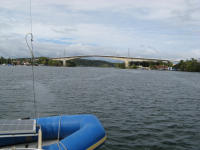 |
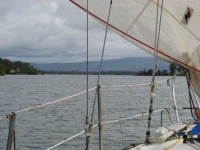 |
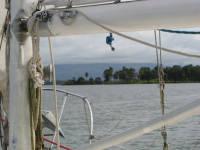 |
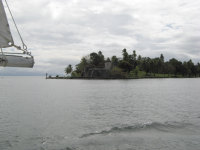 |
| Rio Dulce bridge at Fronteras | Approaching Castillo San Filipe | Bad place to be with canons firing... |
The upper parts of Lago Izabal have a bad reputation, mostly the result of dinghys and outboard motors being stolen by people working out of the town of El Estor on the north shore. I had hoped to be traveling in the company of another boat, but my friends weren't in a position to go at the same time. So I decided to stay clear of the area around El Estor, although I'm not sure how realistic that is. Lago Izabal is fairly large, 25 miles or so long and 5 wide, but that's not much of a constraint to someone working from a launch with a big outboard on it. I headed over towards Denny's Beach, a well-known out-of-the-wayish place on the south shore about a third of the way up.
I had good wind at first, and figured I'd get there about 15:00. But the wind gradually dropped, and I limped in at 17:00 with the sun going down. The wind totally died when I was about 100 yards away from their moorings, but I managed to wash up onto one and snag it. It would have been a shame to have to start the engine for that last little itty bit.
The manager, Robert, was great, bought me a beer and showed me around. I had a great watermelon liquado and a dinner of chicken burritos. The woman at the bar actually joked with me in Spanish, and I understood it, which is a first...
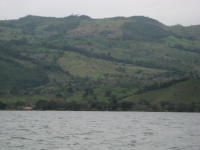 |
 |
| South shore near Denny's Beach | Denny's Beach |
I asked Robert about the possibility of having them take me across the lake to spend the day up El Boqueron, a cool canyon near El Estor. I didn't want to anchor up there and leave Malakii and my dinghy unattended, and thought that would be a good way to see it. But he was unfamiliar with it; they obviously don't take their guests up there. They do run over to the hot spring waterfall at Finca Paraiso, so it surprised me they didn't also go to El Boqueron. I spent the day relaxing and exploring the jungle behind the hotel a little.
There is a well-used path along the shore, running from neighboring villages to the hotel, as many of the people who work there live nearby. As I walked up the lake along the path, I was surprised to discover that when I reached an obvious property line a little ways up, the path was paved! Not only that, but shortly thereafter I moved aside to let a local kid on a skateboard pass. It's probably the only place for miles around where a kid can use one, and he was making good use of it commuting to work.
The next day I continued on west, anxious to see what was at the very head of the lake. There was very little wind, and I once again got a real appreciation for sailors of old. It took me all day to go 15 miles. I left Denny's at 05:20, creaping out with practically no wind. By noon I was only a few miles further, with a top speed of 2 knots for very short periods of time.
 |
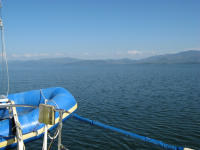 |
| Lago Izabal, south shore |
Finally around 16:00 the wind kicked in and I made some progress. I dropped the hook more or less in the dark. I was headed towards the mouth of the Rio Zarquito, which I didn't have an exact fix on, and by the time I was approaching it was too dark to distinguish the mouth from anything else along the shore. But I had a deep channel most of the way in, and there were a lot of aquatic plants floating out in the bay, clearly washed out from the river, so I figured I was close. I creeped in watching the depth sounder, and when I figured I was "close enough", moved aside and dropped the hook.
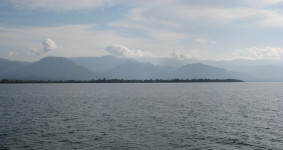 |
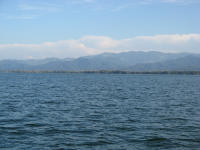 |
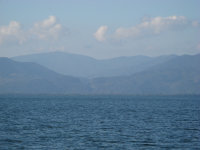 |
| Approaching bay at SW end of Lago Izabal | Sierra de la Minas |
 |
| West End of Lago Izabal, looking SW |
There are a number of rivers that dump into the lake at the west end. The largest, the upper reaches of Rio Dulce, drains a low, broad jungle valley, with mountains on both sides. In the fading light of sunset I was impressed by the Sierra de la Minas, the tall, steep mountains bordering the lake on the southwest. I could see at least one deep canyon cutting through them.
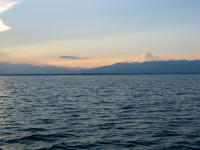 |
 |
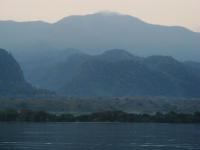 |
 |
| Looking west | Looking southwest | The gorge | Wayward water hyacinths |
Given all the hoopla down river about it being unsafe up at the end of the lake, I was a bit nervous about being robbed. So I had kept my outboard locked in the cockpit locker instead of mounted on the stern pulpit like I normally do, and I locked the dinghy to the boat and kept it on the davits for the night. Then I sharpened my machete and got out the flare gun. And thought about it and laughed... not much of a match for an armed idiot.
After dinner, I rigged my version of Joshua Slocum's boarding alarm. On his first trip around the world, he spread carpet tacks over the deck when he was worried about being boarded, a suitable deterrent for a bare-foot native robber. I had some tacks, but didn't feel like having to sweep them all up. I knew I'd miss one and regret it. So I took my dishes and strew them around on the cockpit seats, figuring it would make quite a racked if someone stumbled on them.
There was a concentrated glow coming from someplace in the jungle on the southwest shore, and the air reverberated with the pulse of music. The village of Potaxte?
I was up in time to watch the sun peek over the mountains to the east, to the accompaniment of multitudes of howler monkeys. What a treat! After a good breakfast, I lowered the dink and put the motor on. After today, anyone on this end of the lake would know I had an outboard. But I was still a mile off the mouth of the river, and I wanted to go up as far as I could, so I needed the outboard.
 |
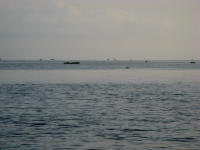 |
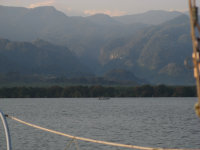 |
| Sunrise, Lago Izabal | Floating Flora | Sierra de la Minas |
I headed towards shore and then motored along, enjoying the birds along the way, hoping for a glimpse of some howlers.
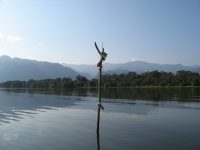 |
 |
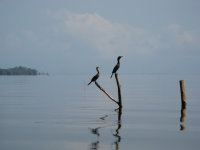 |
| West end, Lago Izabal | Heron | Cormorants |
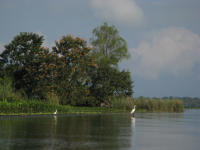 |
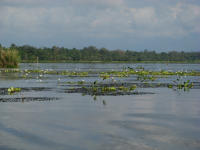 |
| Ibis | Water Hyacinths |
When I got to what I figured was the mouth of the Zarquito, I turned up it. As I putted along, I noticed a number of primitive camps tucked into the trees on the banks.
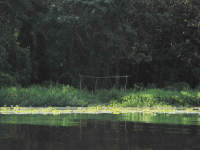 |
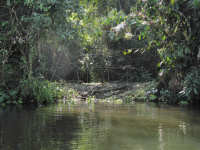 |
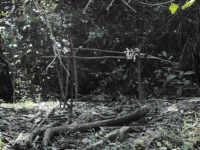 |
| Camp, Rio Zarquito | Zarquito camp | Zarquito camp |
This area, or at least part of it, is in some kind of preserve and is protected to some extent, at least in theory. There were signs posted saying you needed a license to remove wood or fish. I wonder how many people actually have one, and whether it in fact limits the activities? I didn't see a lot of different kinds of birds, but that is at least partly my poor powers of observation, and partly due to the noise of the motor, and partly due to the speed of my travel; I didn't just sit and watch for very long... I wanted to see how far up towards the mountains I could go.
 |
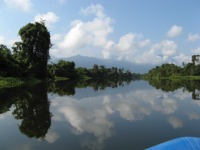 |
 |
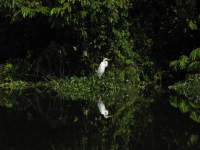 |
| Polochic sign | Rio Zarquito | Fruit | Ibis |
There were not a lot of different flowers blooming along the river, but I did find some pretty eye-popping ones. If anyone knows what these are, please send me an email and tell me (garya at this domain).
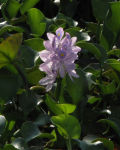 |
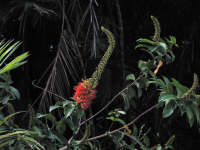 |
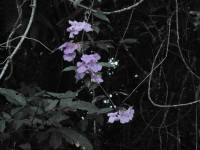 |
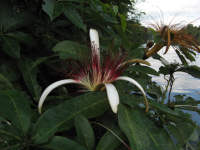 |
| Water Hyacinth | Flower | Flower | Flower |
The Zarquito is a pretty river, with lots of epiphytes hanging onto trees along its banks. Small side creeks entered here and there, a mystery waiting to be explored, too small to pursue in any boat. I passed a cayuco pulled up on shore, its uneven lines a reflection of the tree from which it came, its patches a reminder of accidents from days long past.
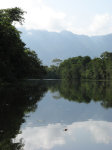 |
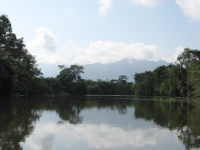 |
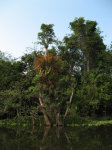 |
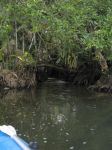 |
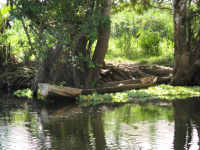 |
| Rio Zarquito | Rio Zarquito | Epiphytes | Side Creek | Cayuco |
I came to a fork in the river, with a sign that simply said "Selempim". I had no idea what this was about -- a river, a family, a village? But the fork went over towards the mountains, and that's what I wanted. I knew if I stayed down in the valley, I would go a long way through the low jungle plain. The river, or creek, gradually decreased in size, and the amount of vegetable matter covering its surface increased. There were water hyacinths everywhere, and eventually there were spots where I had to cut the engine and row or paddle or pole my way through. It felt like I was going somewhere a little remote, until I spotted a coke bottle. The common man goes here, and discards his trash. I kept hoping to run into some howler monkeys, but never did. I scared off an Ibis here and there. I passed wonderfully shaped trees, with large flying buttresses for roots.
Somewhere along the way, I came upon a sign requesting that you report any sightings of animals or particular animal behavior to the people at the village, wherever that was.
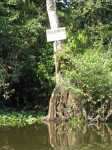 |
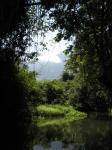 |
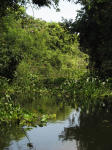 |
 |
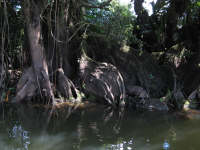 |
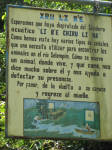 |
| Selempim sign | Tantalizing view | Water hyacinth choked creek | Selempim trash | Cool tree roots | Sign requesting help with animal sightings |
My travel up the river, and now up the creek, was pleasant. I putted along, peering into the trees, peering up the creek ahead. I was hoping to see howlers, or birds, or some other critters. I saw a few birds, and some frogs, but not much else. Occasionally something would go "plop" into the river, and I would be left wondering what I had missed. It was not the most pleasant observing, as the noise of the motor made a quiet approach to anything impossible. When I came to an opening in the jungle I could glimpse the mountains, and I was closing in on them. After an hour or so of slow, pleasant travel, I came to the end of the creek, or rather, the end of navigation on the creek.
I was surprised, to say the least. There was a well constructed dock standing about five feet above the water, with concrete piers and steel ladders. I tied up the dink and climbed onto the dock. I had arrived at Selempim.
I walked down the one street; not sure what I was doing there, and a bit embarrassed. They had a small plantation of palm trees, and a building with some looms which seemed to be long unused.
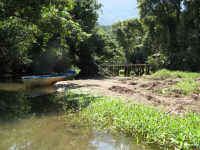 |
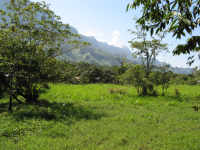 |
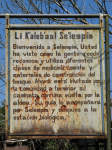 |
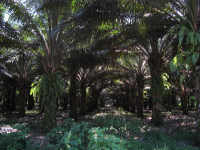 |
| Selempim dock | Selempim village | Selempim sign | Selempim palm plantation |
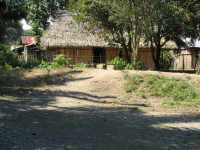 |
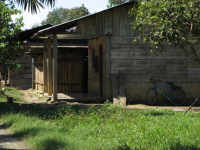 |
 |
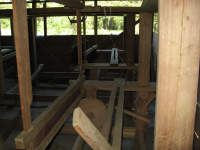 |
| Selempim |
I realized I was no-where near the gorge I had hoped to explore, but I was at the base of the mountains. However, I didn't see an easy way to explore further, and didn't feel like slogging through the jungle from here. As I was making my way back to the dock, a boy on a bike pointed up a trail and told me there was a hotel up there. Right... So I headed up that way to check it out.
I had heard something about being able to hire a boat in El Estor and have someone drop you off over here someplace to explore the jungle. Maybe this was the place. A few hundred yards up the trail, I came to a screened in thatch-roofed building which was the hotel. There were two smaller buildings also, one for the composting toilet, and I'm not sure what the other was for. There was also a solar charger and what looked to be a weather recorder.
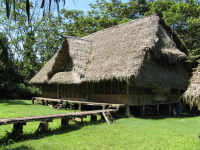 |
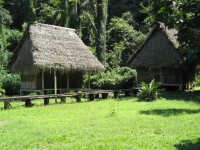 |
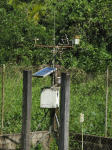 |
| Selempim Hotel |
As I climbed into the dink, some howlers monkeys started sounding off. I headed back down the creek, rowing this time so I could hear, and peering into the trees. Unfortunately, I never did see any of them. Back on the boat, I was surrounded by islands of floating water hyacinths. I stowed the outboard and locked it, put the dinghy up on the davits. As I was relaxing into the evening the wind died completely and the mosquitoes invaded, in spite of me being anchored at least a mile off the coast. I ended up with mosquito coils going, my headnet on, a shirt and foul weather jacket, long pants and socks and foul weather pants, suffocatingly hot, and still got bit. I had the cruising guides open to the Lago Izabal pages, now covered with squished mosquitos and my blood.
An hour or so later an evening thunderstorm blew through. Good news -- it got rid of the mosquitos. I got a good night's sleep in spite of some worrying about having the motor or dinghy stolen. I'm slowly learning to do what I can, and then not be too strung out about what I can't do anything about.
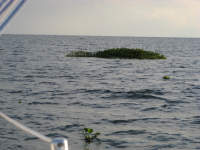 |
| Water Hyacinths |
The next morning I sailed over to Finca Paraiso. I was thinking originally I would try to see El Boqueron, the cool canyon near El Estor, but I couldn't come up with a safe way to leave the boat while I did it. Something for next time, or a land excursion. I spent a leisurely evening at Finca Paraiso, then sailed back to the river the next day. I spent the night anchored off Fronteras, and had dinner with my friends Kris and Tom on Dragon Lady. The next morning I did some shopping, read email, and helped Tom with a few electrical odds and ends. Then I headed on down the river. Since I got a late start, it was getting late as I entered the Golfete. I was beating into the wind, as expected, and it was going to be a stretch to make it to Jennifer's by dark. I wasn't particularly concerned about sailing down there in the dark, but the local fishermen go out and put nets all over the lake starting at dusk, and I really didn't want to get snagged in them or mess them up. I finally said to myself, "This is dumb," and pulled over near Cayo Julio and dropped the hook. I had a wonderful relaxed evening all to myself.
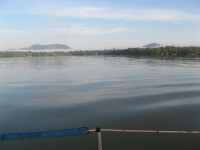 |
 |
| Bay near Cayo Julio on El Golfete |
The next morning I sailed down to Jennifer's and snagged my mooring. The rebuilt steering worked great, and everything else seemed to be in good shape, so Malakii and I were ready for Dona's visit.